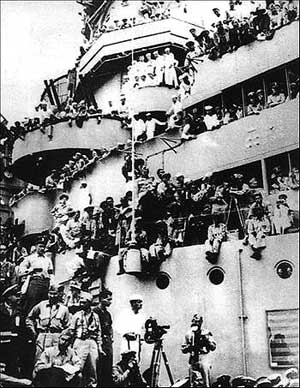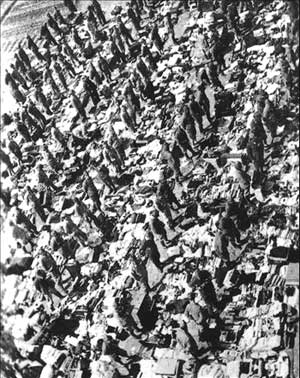On September 18, 1931, Japanese aggressors started an undeclared war by engineering the September 18 Incident in China's northeast. Later, with the incident as the beginning, Japan launched frenzied and full-scale war of aggression against China. The war flames burned as long as 14 years, plunging countless Chinese people into the abyss of suffering.
When the nation's existence was in peril, the Chinese nation, united under the banner of the anti-Japanese national united front, feared no difficulties and hardships, was unafraid of bloodshed and sacrifice, shared a bitter hatred of the enemy and rose up in resistance. From the "800 heroic men" fighting bloody war in Wusong and Shanghai to battling the enemy with broadswords in Taierzhuang, from the armed working team in the enemy's rear areas to railway guerrilla war, and from shooting a famous general of the Japanese army to death in Huangtuling to the 100 regiment campaign. The flames of the Chinese nation's War of Resistance Against Japanese Aggression threw the arrogant Japanese aggressors into the vast sea of the people's war.
In August 1945, the Chinese anti-Japanese armed forces launched an all-round counterattack against the Japanese army. Zhu De ordered Japanese army to surrender to the people's armed forces, but this was subject to the obstruction by the US and the Kuomintang government. On August 21, representative of the Chinese army summoned the representative of Japanese army for talks on Japan's surrender at Zhijiang of Hunan Province, and instructed the Japanese side on the matter concerning preparation for its surrender. On September 9, the signing ceremony for the surrender of the Japanese army in the Chinese war zone was held in Nanjing. Representative of the Chinese side He Yingqin, commander-in-chief, presided over the ceremony for accepting Japan's surrender. Representative for Japanese surrender, commander-in-chief of Japanese army invading China Okamura Yasuji in the China war zone signed the document on surrender. The 1.28 million Japanese aggressor troops surrendered to China. By the time, the Chinese people, after fighting bloody war and expending great national sacrifice, finally defeated Japanese militarism and won great victory in the War of Resistance Against Japanese Aggression.
Mao Zedong once made the following appraisal: The Chinese Anti-Japanese War is a "marvelous spectacle in the war history, the magnificent feat of the Chinese nation, and an earthshaking undertaking." After 14 years of heroic struggle and bloody war, the Chinese people, under the banner of the CPC-initiated anti-Japanese national united front and using backward weapons and equipment, defeated the powerful enemy that was stronger than China in terms of economic strength and military equipment, and wrought the miracle of defeating the imperialist power by a weak semi-colonial country. This earthshaking great undertaking enabled the Chinese nation to wipe out a hundred-year-old humiliation and to show its new image in the world.

The ceremony for Japan's surrender to the allied forces held on the USS Missouri warship in Tokyo Bay. (People's Daily Photo)

Sailors and photographers on the USS Missouri warship awaiting Japan's surrender to the allied forces, an instance of historic significance. (People's Daily Photo)

On September 9, 1945, on behalf of the Chinese government in Nanjing, He Yingqin (L) accepted the letter of surrender presented by commander-in-chief Okamura Yasuji of Japanese aggressor troops. (People's Daily Photo)

On August 21, 1945, Japanese officers sent out by Okamura Yasuji, commander-in-chief of Japanese aggressor troops in Zhijiang of Hunan Province had talks with Chinese army on Japan's surrender. (People's Daily Photo)

Soldiers of Japanese aggressor troops assembled in Wuhan after their surrender. (People's Daily Photo)

Japanese aggressor troops laid down their arms and surrendered. (People's Daily Photo)

Hideki Tojo, wartime Japanese prime minister, had an attempted suicide with his pistol. (People's Daily Photo)

